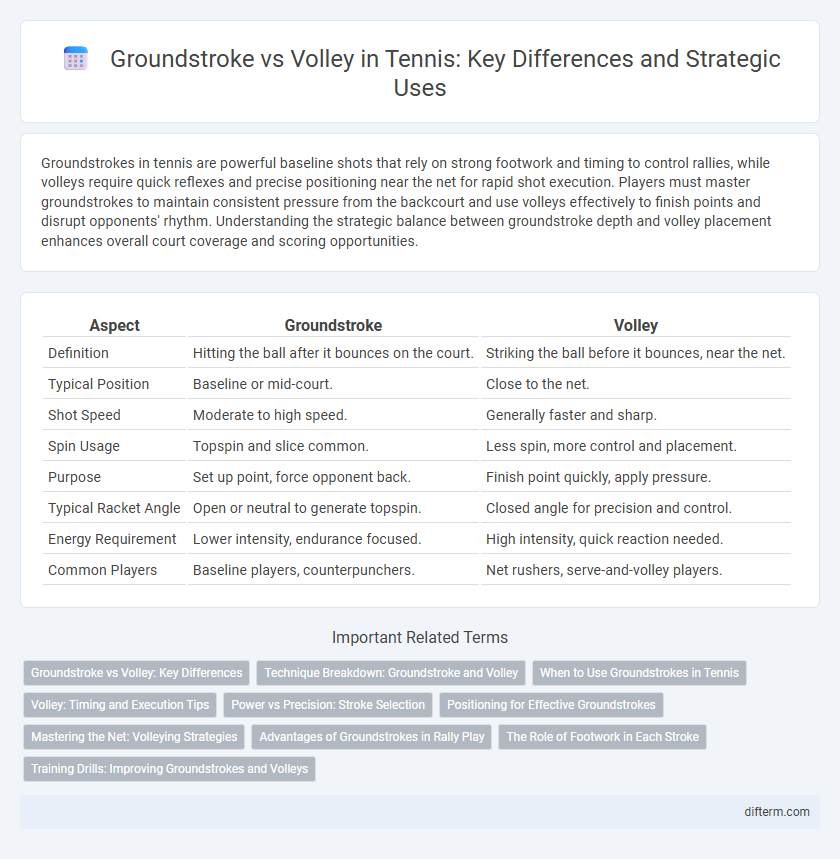Groundstrokes in tennis are powerful baseline shots that rely on strong footwork and timing to control rallies, while volleys require quick reflexes and precise positioning near the net for rapid shot execution. Players must master groundstrokes to maintain consistent pressure from the backcourt and use volleys effectively to finish points and disrupt opponents' rhythm. Understanding the strategic balance between groundstroke depth and volley placement enhances overall court coverage and scoring opportunities.
Table of Comparison
| Aspect | Groundstroke | Volley |
|---|---|---|
| Definition | Hitting the ball after it bounces on the court. | Striking the ball before it bounces, near the net. |
| Typical Position | Baseline or mid-court. | Close to the net. |
| Shot Speed | Moderate to high speed. | Generally faster and sharp. |
| Spin Usage | Topspin and slice common. | Less spin, more control and placement. |
| Purpose | Set up point, force opponent back. | Finish point quickly, apply pressure. |
| Typical Racket Angle | Open or neutral to generate topspin. | Closed angle for precision and control. |
| Energy Requirement | Lower intensity, endurance focused. | High intensity, quick reaction needed. |
| Common Players | Baseline players, counterpunchers. | Net rushers, serve-and-volley players. |
Groundstroke vs Volley: Key Differences
Groundstrokes in tennis involve hitting the ball after it bounces, allowing players to generate power and control from the baseline, while volleys require striking the ball before it bounces, emphasizing quick reflexes and positioning near the net. Groundstrokes rely on topspin and pace to push opponents back, whereas volleys prioritize precision and angles to finish points efficiently. Mastery of both techniques enables players to adapt their strategy, balancing baseline rallies with aggressive net play.
Technique Breakdown: Groundstroke and Volley
Groundstrokes in tennis emphasize powerful baseline shots with a smooth swing path, aiming for depth and consistency, using topspin to control ball trajectory and bounce. Volleys require quick reflexes at the net, focusing on a short, compact swing and proper positioning to redirect the opponent's shot with precision and speed. Mastery of groundstroke technique builds rally foundation, while volley technique enhances net play dominance and point-finishing ability.
When to Use Groundstrokes in Tennis
Groundstrokes are most effective during baseline rallies, allowing players to dictate pace and keep opponents deep behind the court. Players should use groundstrokes when they have time to set up for powerful and consistent forehand or backhand shots. Employing groundstrokes is advantageous in longer points, where sustaining depth and accuracy pressures opponents into errors.
Volley: Timing and Execution Tips
Volley in tennis demands precise timing to intercept the ball near the net, minimizing opponent's reaction time. Executing effective volleys requires a firm grip, compact swing, and quick reflexes to maintain control and angle placement. Mastering the split-step before the opponent's shot enhances balance and readiness, improving volley success rates.
Power vs Precision: Stroke Selection
Groundstrokes in tennis emphasize power, generating forceful shots from the baseline to control rallies and push opponents deep. Volleys prioritize precision, relying on quick reflexes and accurate placement near the net to exploit openings. Choosing between groundstroke and volley depends on strategic balance, with powerful groundstrokes setting up precise volleys for effective point construction.
Positioning for Effective Groundstrokes
Optimal positioning for effective groundstrokes in tennis requires players to maintain a balanced stance near the baseline, allowing quick lateral movement and powerful shot execution. Footwork patterns emphasize staying low with bent knees to absorb ball impact and generate topspin through rotational hips and shoulders. Anticipating the opponent's shot direction enhances readiness, enabling precise timing and control during groundstroke rallies.
Mastering the Net: Volleying Strategies
Effective volleying in tennis demands quick reflexes and precise placement, allowing players to seize control at the net and cut off opponents' angles. Developing a sharp, compact swing combined with strategic positioning enhances volley success rates and pressures opponents into defensive shots. Mastering net play exploits the transient nature of volleys, transforming rapid exchanges into scoring opportunities and dictating the pace of the match.
Advantages of Groundstrokes in Rally Play
Groundstrokes provide better control and consistency during long rally exchanges, allowing players to maintain baseline dominance and dictate the pace of the game. They offer increased time to react to opponent shots and set up strategic placements, minimizing unforced errors compared to more sudden volleys. The topspin generated in groundstrokes enhances ball stability and bounce predictability, giving players reliable shot-making options in extended rallies.
The Role of Footwork in Each Stroke
Footwork plays a crucial role in executing both groundstrokes and volleys in tennis, as it directly affects balance and positioning. Groundstrokes require dynamic lateral movement and stable weight transfer to generate power from the baseline, while volleys demand quick, precise steps and compact foot positioning near the net to react efficiently. Mastery of footwork enhances stroke consistency and control in high-speed court exchanges.
Training Drills: Improving Groundstrokes and Volleys
Effective training drills for improving groundstrokes in tennis emphasize consistent ball striking from the baseline, incorporating repetitive forehand and backhand swings to build power and control. In contrast, volley drills focus on quick reflexes and positioning near the net, using rapid-fire exchanges and reaction ball exercises to enhance hand-eye coordination. Combining these drills in practice sessions helps players develop all-court skills, optimizing their ability to transition smoothly between baseline rallies and net play.
groundstroke vs volley (tennis) Infographic

 difterm.com
difterm.com